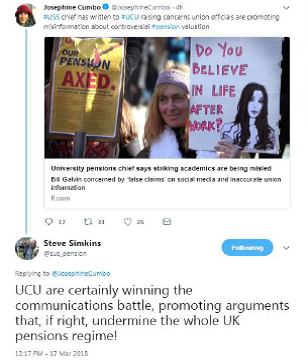Since my last post on the strike, where I set out my reasons for not joining it, a lot has happened. The strike has forced UUK back to the negotiating table, overseen by ACAS, on a deal originally presented as done. The consultation period on the new arrangements has been postponed. University Vice Chancellors are scurrying to distance themselves from the UUK negotiating position and side with their own striking lecturers. As most observers admit, including most recently the Head of Public Sector Pensions at KPMG in the tweet below, the UCU have won the communications battle. Victory appears to be total.
However there remains a problem, which we seem to be facing increasingly in recent years from Trump to Brexit, and that is this: what to do when the victory you have won is based on campaign arguments which are fundamentally untrue, not backed by evidence or existing pensions legislation, and ultimately undeliverable? Just keep saying no to any workable option which is put to you?
How untrue? Well let’s go back to the now famous letter to the FT signed by many famous lecturers across the UK, including David Spiegelhalter, Ben Goldacre and Steven Haberman (notable as he is deputy director of the Actuarial Research Centre). This was itself a response to a FT story based on the audited accounts, where the pension deficits were merely being updated in line with what had previously been agreed and bore no relation to the negotiations about the March 2017 valuation. As the audited accounts state quite clearly:
The trustee regularly monitors the scheme’s funding position as part of the overall monitoring of FMP introduced followed the 2014 valuation. The monitoring is based on the assumptions used for the 2014 actuarial valuation (updated for changes in gilt yields and inflation expectations). The monitoring does not involve the same detailed review of the underlying assumptions (including the financial, economic, sectoral assumptions for example) that takes place as part of the full actuarial valuation, the next full actuarial valuation being due as at 31 March 2017. Therefore the amounts shown for liabilities in the funding position below are not indicative of the results of the 2017 valuation.
So arguing about these assumptions was futile. The letter also showed an unexpected lack of understanding (particularly from Steven Haberman, who must have spent enough time in the company of pensions actuaries who carry out these kinds of negotiations all the time to know better) about what the assumptions shown in the accounts meant. In particular, there is a note saying that the general salary assumption is only being used for the recovery plan contributions rather than to calculate the scheme deficit. That means that, if you think the assumption is too large, it will be overstating the value of future contributions and therefore understating how large those contributions need to be. So rather than making the scheme seem more unaffordable, it would be making it seem less.
Then there is the mortality point – a massive misunderstanding. The assumptions do not say that life expectancy is increasing by 1.5% pa which would clearly be absurd. They are saying that mortality improvements (ie the percentage by which the expected probability of death of a 70 year old in 2020 is less than that of a 70 year old in 2019) are assumed to be 1.5% pa. Stuart McDonald gently put Ben Goldacre right on this point here.
However the bigger overall point is that individual assumptions are not the thing to focus on here anyway, but the overall level of prudence or otherwise in a basis. And the facts around this are considerably clearer.
- We know that the initial valuation proposed by the USS Trustee to the Pensions Regulator and the covenant assessment on which it was based (ie the willingness and ability of the employers in UUK to continue paying contributions) were both rejected. As this initial valuation disclosed a deficit of just over £5 billion, then the proposal resulting in a £7.5 billion deficit which was finally presented to the Joint Negotiating Committee would appear to be as low as the Trustee could reasonably go and still get the valuation past the Regulator.
- The S179 valuation of the scheme (this is the valuation all occupational pension schemes who pay levies to the Pension Protection Fund as insurance against the failure of their employer(s), which is done on the same valuation basis for all schemes) at the last valuation as at 31 March 2014 showed a deficit of £8.95 billion (compared to the £5.3 billion funding deficit disclosed). The latest “more prudent” valuation proposed is therefore still unlikely to be proposing a target which goes anywhere near 100% funding on this basis (the scheme was only 82% funded in March 2014 when, as you can see below, nearly 40% of schemes were in surplus on this measure). There is therefore no justification for the repeated assertion by the UCU that the scheme is not under-funded.

Source: Commons Work and Pensions Select Committee report on defined benefit pension schemes 20 December 2016
One last point on the campaign. Some of it seems to have been directed personally at the USS Trustee. This is the body with no other job than to protect the security of the pensions that lecturers have already built up. Why would anyone want to turn on them? Bill Galvin, the Group CEO at USS Ltd, the Trustee company, has set out responses to some of the other misconceptions here. I would urge anyone with an interest in this dispute to read them.
So, if the deficit is what it is and there is no scope for weakening the funding assumptions any further and maintaining current benefits on these funding assumptions involves contribution increases which are unacceptable to both scheme members and the employers, what is this dispute about now? The time has come for lecturers to decide what they want. Of course the basic premises of pension scheme funding can be argued about (and I direct anyone interested in the long history of actuarial debate in this area to read chapter 6 of Craig Turnbull’s A History of British Actuarial Thought which traces this from 1875 to 1997), and perhaps ultimately legislative change might be brought about if a new argument could be won in this area. But that is a long term objective and the funding of this scheme needs to be agreed now. If a £42,000 cap for 3 years while negotiations continue on a long term structure of the scheme which doesn’t leave all risk with scheme members is not acceptable, then we need to decide pretty quickly what is. Because once we move to a DC arrangement, the chances of us moving back to any form of risk sharing subsequently are in my view remote. There will always be other uses for that money.
However there are many possible alternative structures and many ways of sharing the risks between employers and scheme members. In particular let’s not get too obsessed with Collective Defined Contribution schemes, the enabling legislation for which has yet to materialise. Consider all the alternatives and let proper negotiations commence!



